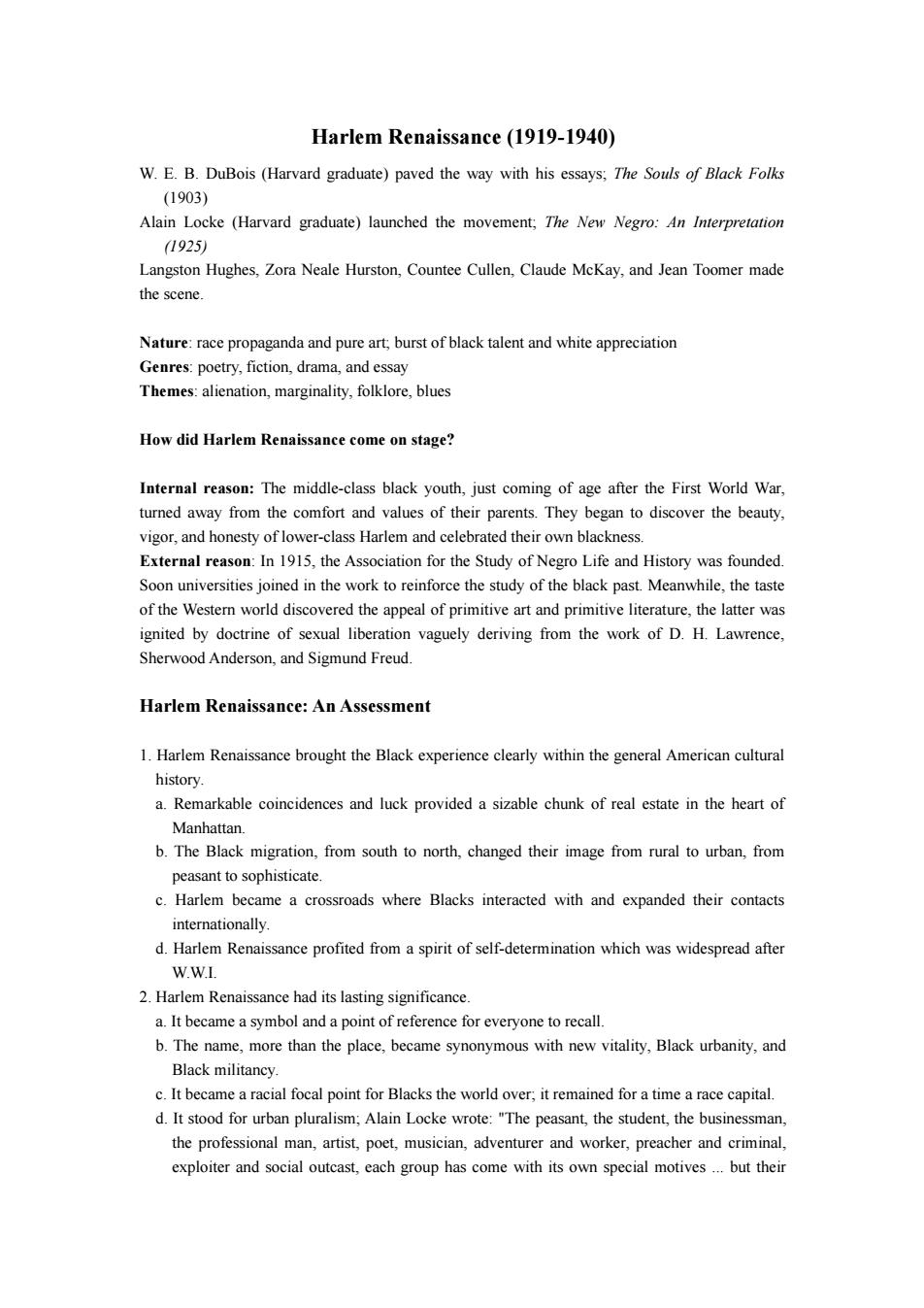
Harlem Renaissance (1919-1940) W.E.B.DuBois(Harvard graduate)paved the way with his essays;The Souls of Black Folks (1903) Alain Locke (Harvard graduate)launched the movement;The New Negro:An Interpretation 1925) Langston Hughes,Zora Neale Hurston,Countee Cullen,Claude McKay,and Jean Toomer made the scene. Nature:race propaganda and pure art,burst of black talent and white appreciation Genres:poetry,fiction,drama,and essay Themes:alienation,marginality,folklore,blues How did Harlem Renaissance come on stage? Internal reason:The middle-class black youth,just coming of age after the First World War, turned away from the comfort and values of their parents.They began to discover the beauty, vigor,and honesty of lower-class Harlem and celebrated their own blackness. External reason:In 1915,the Association for the Study of Negro Life and History was founded. Soon universities joined in the work to reinforce the study of the black past.Meanwhile,the taste of the Western world discovered the appeal of primitive art and primitive literature,the latter was ignited by doctrine of sexual liberation vaguely deriving from the work of D.H.Lawrence, Sherwood Anderson,and Sigmund Freud. Harlem Renaissance:An Assessment 1.Harlem Renaissance brought the Black experience clearly within the general American cultural history. a.Remarkable coincidences and luck provided a sizable chunk of real estate in the heart of Manhattan. b.The Black migration,from south to north,changed their image from rural to urban,from peasant to sophisticate. c.Harlem became a crossroads where Blacks interacted with and expanded their contacts internationally. d.Harlem Renaissance profited from a spirit of self-determination which was widespread after W.WI. 2.Harlem Renaissance had its lasting significance. a.It became a symbol and a point of reference for everyone to recall. b.The name,more than the place,became synonymous with new vitality,Black urbanity,and Black militancy c.It became a racial focal point for Blacks the world over;it remained for a time a race capital. d.It stood for urban pluralism;Alain Locke wrote:"The peasant,the student,the businessman, the professional man,artist,poet,musician,adventurer and worker,preacher and criminal, exploiter and social outcast,each group has come with its own special motives...but their
Harlem Renaissance (1919-1940) W. E. B. DuBois (Harvard graduate) paved the way with his essays; The Souls of Black Folks (1903) Alain Locke (Harvard graduate) launched the movement; The New Negro: An Interpretation (1925) Langston Hughes, Zora Neale Hurston, Countee Cullen, Claude McKay, and Jean Toomer made the scene. Nature: race propaganda and pure art; burst of black talent and white appreciation Genres: poetry, fiction, drama, and essay Themes: alienation, marginality, folklore, blues How did Harlem Renaissance come on stage? Internal reason: The middle-class black youth, just coming of age after the First World War, turned away from the comfort and values of their parents. They began to discover the beauty, vigor, and honesty of lower-class Harlem and celebrated their own blackness. External reason: In 1915, the Association for the Study of Negro Life and History was founded. Soon universities joined in the work to reinforce the study of the black past. Meanwhile, the taste of the Western world discovered the appeal of primitive art and primitive literature, the latter was ignited by doctrine of sexual liberation vaguely deriving from the work of D. H. Lawrence, Sherwood Anderson, and Sigmund Freud. Harlem Renaissance: An Assessment 1. Harlem Renaissance brought the Black experience clearly within the general American cultural history. a. Remarkable coincidences and luck provided a sizable chunk of real estate in the heart of Manhattan. b. The Black migration, from south to north, changed their image from rural to urban, from peasant to sophisticate. c. Harlem became a crossroads where Blacks interacted with and expanded their contacts internationally. d. Harlem Renaissance profited from a spirit of self-determination which was widespread after W.W.I. 2. Harlem Renaissance had its lasting significance. a. It became a symbol and a point of reference for everyone to recall. b. The name, more than the place, became synonymous with new vitality, Black urbanity, and Black militancy. c. It became a racial focal point for Blacks the world over; it remained for a time a race capital. d. It stood for urban pluralism; Alain Locke wrote: "The peasant, the student, the businessman, the professional man, artist, poet, musician, adventurer and worker, preacher and criminal, exploiter and social outcast, each group has come with its own special motives ... but their
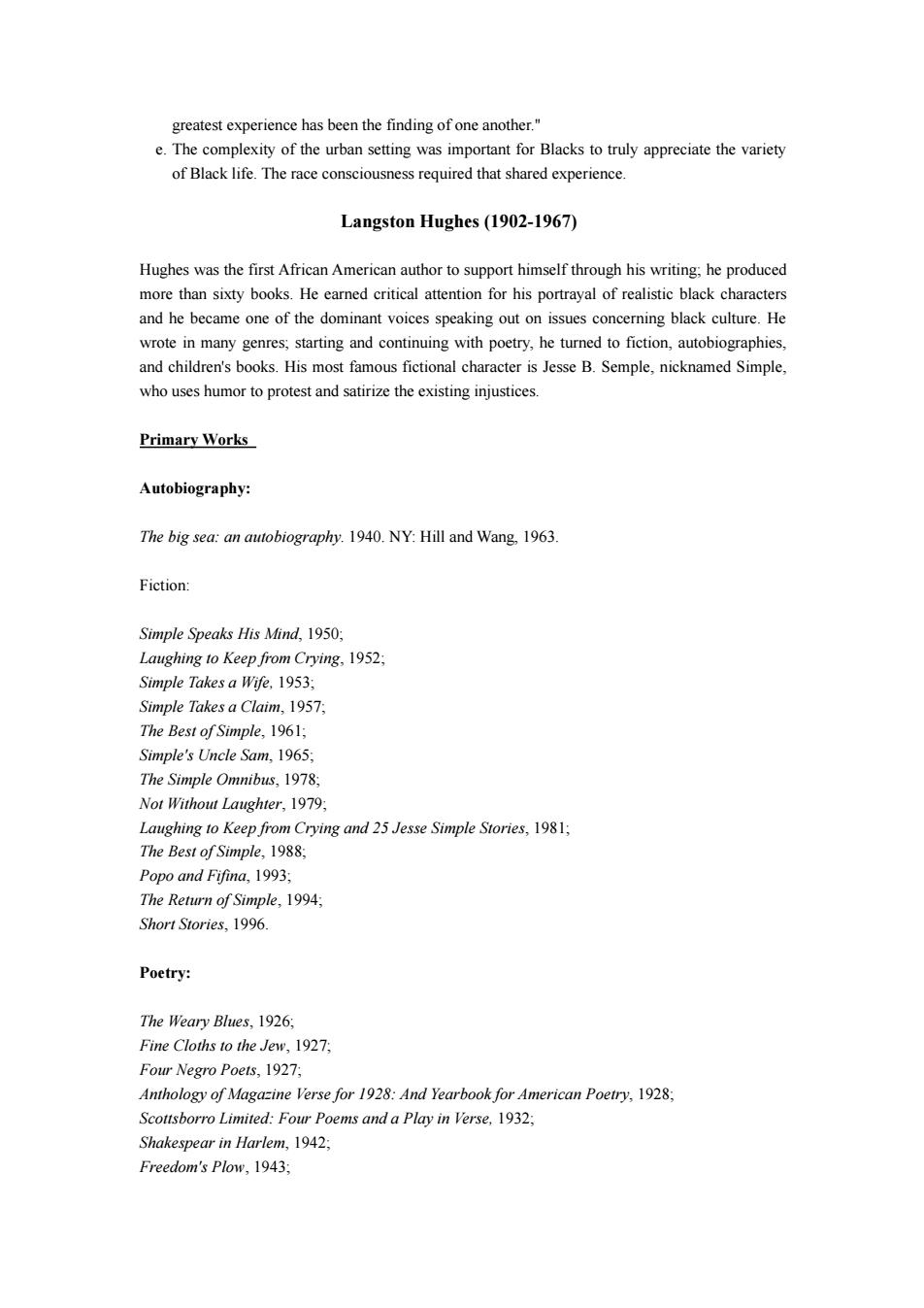
greatest experience has been the finding of one another." e.The complexity of the urban setting was important for Blacks to truly appreciate the variety of Black life.The race consciousness required that shared experience. Langston Hughes (1902-1967) Hughes was the first African American author to support himself through his writing;he produced more than sixty books.He earned critical attention for his portrayal of realistic black characters and he became one of the dominant voices speaking out on issues concerning black culture.He wrote in many genres;starting and continuing with poetry,he turned to fiction,autobiographies, and children's books.His most famous fictional character is Jesse B.Semple,nicknamed Simple, who uses humor to protest and satirize the existing injustices. Primary Works Autobiography: The big sea:an autobiography.1940.NY:Hill and Wang,1963. Fiction: Simple Speaks His Mind,1950; Laughing to Keep from Crying,1952; Simple Takes a Wife,1953; Simple Takes a Claim,1957; The Best of Simple,1961; Simple's Uncle Sam,1965; The Simple Omnibus,1978; Not Without Laughter,1979; Laughing to Keep from Crying and 25 Jesse Simple Stories,1981; The Best of Simple,1988; Popo and Fifina,1993; The Return of Simple.1994: Short Stories,1996. Poetry: The Weary Blues,1926; Fine Cloths to the Jew,1927; Four Negro Poets,1927; Anthology of Magazine Verse for 1928:And Yearbook for American Poetry,1928, Scottsborro Limited:Four Poems and a Play in Verse,1932; Shakespear in Harlem,1942; Freedom's Plow.1943:
greatest experience has been the finding of one another." e. The complexity of the urban setting was important for Blacks to truly appreciate the variety of Black life. The race consciousness required that shared experience. Langston Hughes (1902-1967) Hughes was the first African American author to support himself through his writing; he produced more than sixty books. He earned critical attention for his portrayal of realistic black characters and he became one of the dominant voices speaking out on issues concerning black culture. He wrote in many genres; starting and continuing with poetry, he turned to fiction, autobiographies, and children's books. His most famous fictional character is Jesse B. Semple, nicknamed Simple, who uses humor to protest and satirize the existing injustices. Primary Works Autobiography: The big sea: an autobiography. 1940. NY: Hill and Wang, 1963. Fiction: Simple Speaks His Mind, 1950; Laughing to Keep from Crying, 1952; Simple Takes a Wife, 1953; Simple Takes a Claim, 1957; The Best of Simple, 1961; Simple's Uncle Sam, 1965; The Simple Omnibus, 1978; Not Without Laughter, 1979; Laughing to Keep from Crying and 25 Jesse Simple Stories, 1981; The Best of Simple, 1988; Popo and Fifina, 1993; The Return of Simple, 1994; Short Stories, 1996. Poetry: The Weary Blues, 1926; Fine Cloths to the Jew, 1927; Four Negro Poets, 1927; Anthology of Magazine Verse for 1928: And Yearbook for American Poetry, 1928; Scottsborro Limited: Four Poems and a Play in Verse, 1932; Shakespear in Harlem, 1942; Freedom's Plow, 1943;
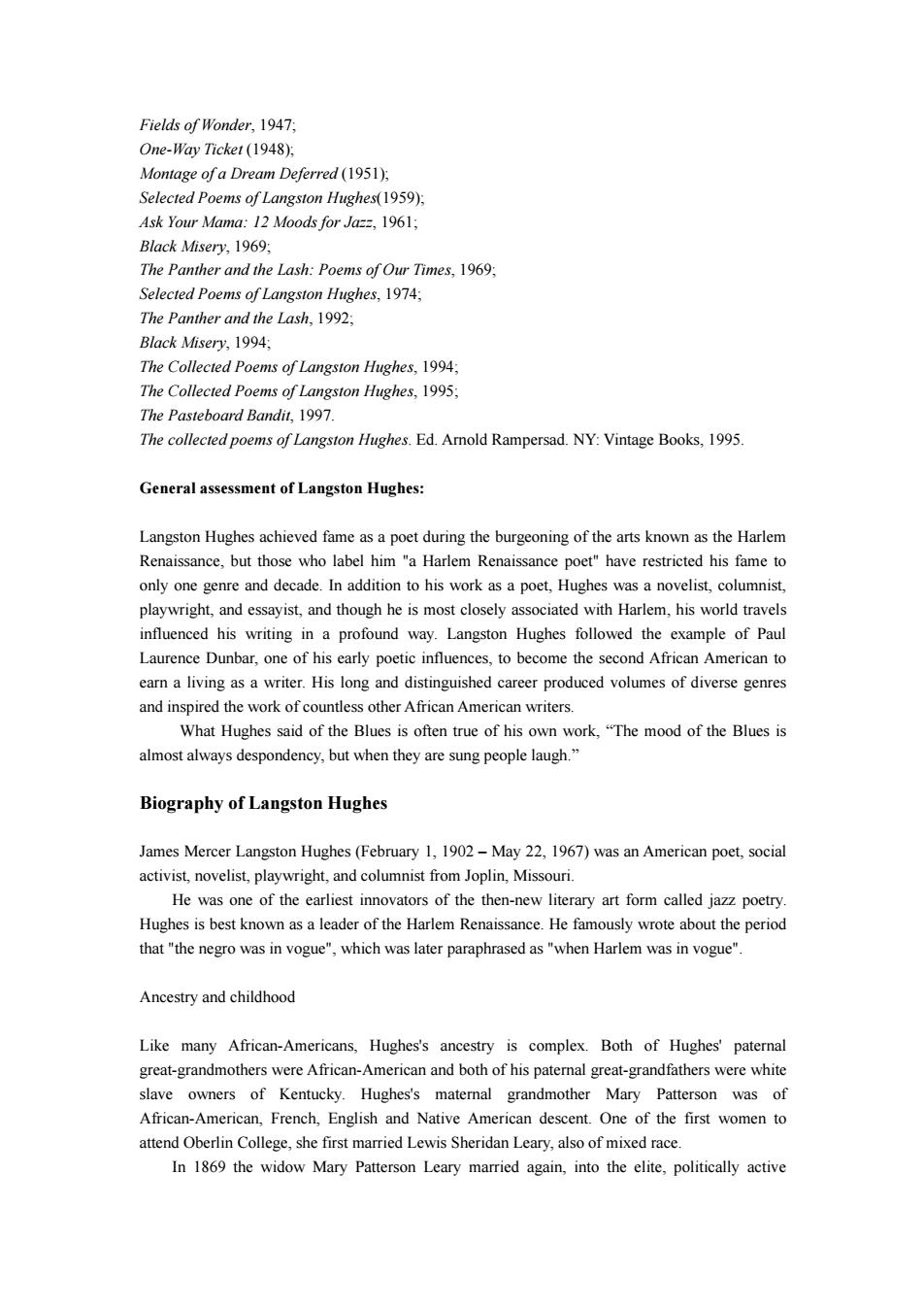
Fields of Wonder,1947; One-Way Ticket (1948); Montage ofa Dream Deferred (1951); Selected Poems of Langston Hughes(1959). Ask Your Mama:12 Moods for Jazz,1961; Black Misery,1969; The Panther and the Lash:Poems of Our Times,1969; Selected Poems of Langston Hughes,1974; The Panther and the Lash,1992; Black Misery,1994; The Collected Poems of Langston Hughes,1994; The Collected Poems of Langston Hughes,1995; The Pasteboard Bandit.1997. The collected poems of Langston Hughes.Ed.Arnold Rampersad.NY:Vintage Books,1995. General assessment of Langston Hughes: Langston Hughes achieved fame as a poet during the burgeoning of the arts known as the Harlem Renaissance,but those who label him "a Harlem Renaissance poet"have restricted his fame to only one genre and decade.In addition to his work as a poet,Hughes was a novelist,columnist, playwright,and essayist,and though he is most closely associated with Harlem,his world travels influenced his writing in a profound way.Langston Hughes followed the example of Paul Laurence Dunbar,one of his early poetic influences,to become the second African American to earn a living as a writer.His long and distinguished career produced volumes of diverse genres and inspired the work of countless other African American writers. What Hughes said of the Blues is often true of his own work,"The mood of the Blues is almost always despondency,but when they are sung people laugh." Biography of Langston Hughes James Mercer Langston Hughes(February 1,1902-May 22,1967)was an American poet,social activist,novelist,playwright,and columnist from Joplin,Missouri. He was one of the earliest innovators of the then-new literary art form called jazz poetry. Hughes is best known as a leader of the Harlem Renaissance.He famously wrote about the period that "the negro was in vogue",which was later paraphrased as "when Harlem was in vogue". Ancestry and childhood Like many African-Americans,Hughes's ancestry is complex.Both of Hughes'paternal great-grandmothers were African-American and both of his paternal great-grandfathers were white slave owners of Kentucky.Hughes's maternal grandmother Mary Patterson was of African-American,French,English and Native American descent.One of the first women to attend Oberlin College,she first married Lewis Sheridan Leary,also of mixed race. In 1869 the widow Mary Patterson Leary married again,into the elite,politically active
Fields of Wonder, 1947; One-Way Ticket (1948); Montage of a Dream Deferred (1951); Selected Poems of Langston Hughes(1959); Ask Your Mama: 12 Moods for Jazz, 1961; Black Misery, 1969; The Panther and the Lash: Poems of Our Times, 1969; Selected Poems of Langston Hughes, 1974; The Panther and the Lash, 1992; Black Misery, 1994; The Collected Poems of Langston Hughes, 1994; The Collected Poems of Langston Hughes, 1995; The Pasteboard Bandit, 1997. The collected poems of Langston Hughes. Ed. Arnold Rampersad. NY: Vintage Books, 1995. General assessment of Langston Hughes: Langston Hughes achieved fame as a poet during the burgeoning of the arts known as the Harlem Renaissance, but those who label him "a Harlem Renaissance poet" have restricted his fame to only one genre and decade. In addition to his work as a poet, Hughes was a novelist, columnist, playwright, and essayist, and though he is most closely associated with Harlem, his world travels influenced his writing in a profound way. Langston Hughes followed the example of Paul Laurence Dunbar, one of his early poetic influences, to become the second African American to earn a living as a writer. His long and distinguished career produced volumes of diverse genres and inspired the work of countless other African American writers. What Hughes said of the Blues is often true of his own work, “The mood of the Blues is almost always despondency, but when they are sung people laugh.” Biography of Langston Hughes James Mercer Langston Hughes (February 1, 1902 – May 22, 1967) was an American poet, social activist, novelist, playwright, and columnist from Joplin, Missouri. He was one of the earliest innovators of the then-new literary art form called jazz poetry. Hughes is best known as a leader of the Harlem Renaissance. He famously wrote about the period that "the negro was in vogue", which was later paraphrased as "when Harlem was in vogue". Ancestry and childhood Like many African-Americans, Hughes's ancestry is complex. Both of Hughes' paternal great-grandmothers were African-American and both of his paternal great-grandfathers were white slave owners of Kentucky. Hughes's maternal grandmother Mary Patterson was of African-American, French, English and Native American descent. One of the first women to attend Oberlin College, she first married Lewis Sheridan Leary, also of mixed race. In 1869 the widow Mary Patterson Leary married again, into the elite, politically active
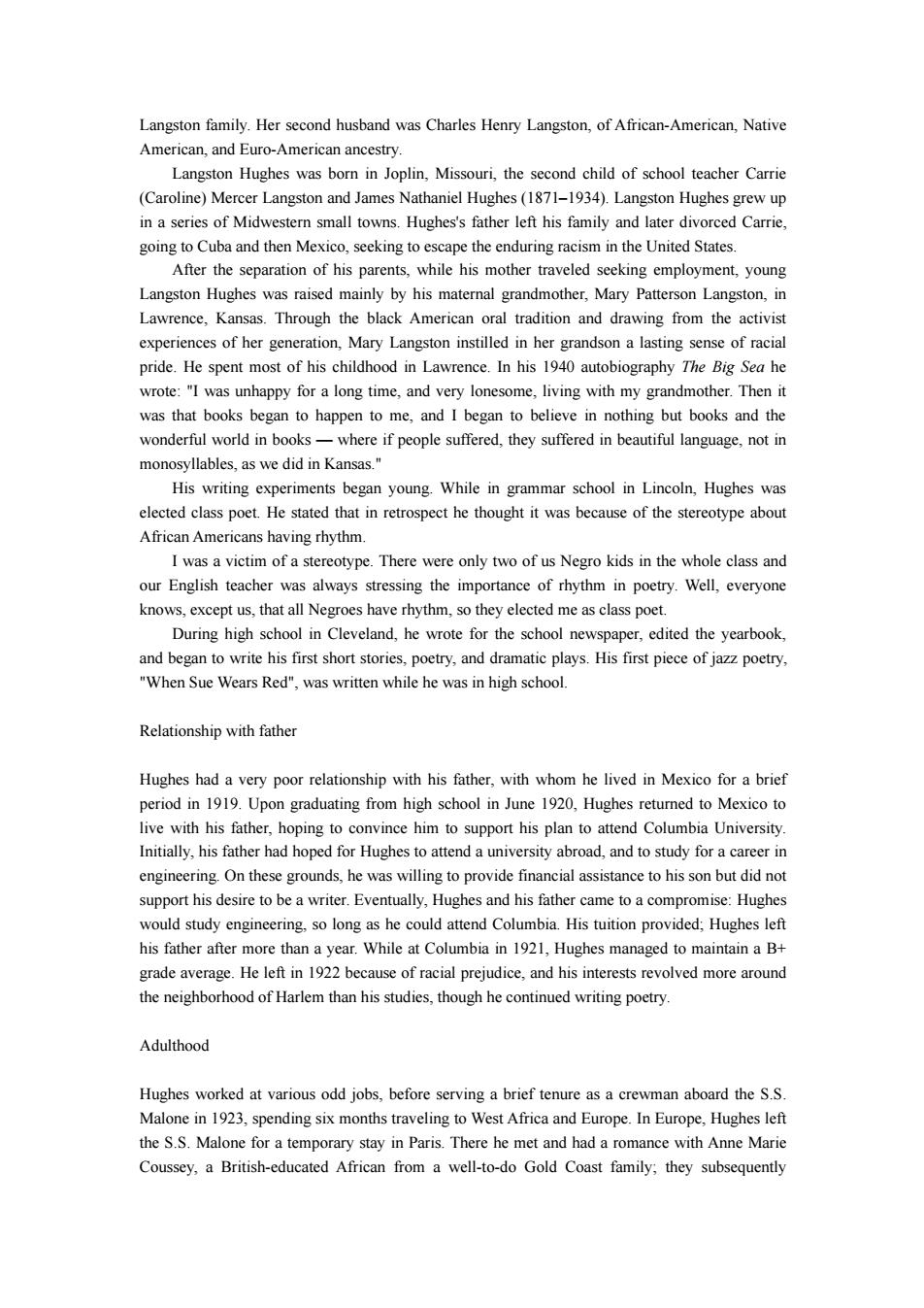
Langston family.Her second husband was Charles Henry Langston,of African-American,Native American,and Euro-American ancestry. Langston Hughes was born in Joplin,Missouri,the second child of school teacher Carrie (Caroline)Mercer Langston and James Nathaniel Hughes(1871-1934).Langston Hughes grew up in a series of Midwestern small towns.Hughes's father left his family and later divorced Carrie, going to Cuba and then Mexico,seeking to escape the enduring racism in the United States After the separation of his parents,while his mother traveled seeking employment,young Langston Hughes was raised mainly by his maternal grandmother,Mary Patterson Langston,in Lawrence,Kansas.Through the black American oral tradition and drawing from the activist experiences of her generation,Mary Langston instilled in her grandson a lasting sense of racial pride.He spent most of his childhood in Lawrence.In his 1940 autobiography The Big Sea he wrote:"I was unhappy for a long time,and very lonesome,living with my grandmother.Then it was that books began to happen to me,and I began to believe in nothing but books and the wonderful world in books-where if people suffered,they suffered in beautiful language,not in monosyllables,as we did in Kansas." His writing experiments began young.While in grammar school in Lincoln,Hughes was elected class poet.He stated that in retrospect he thought it was because of the stereotype about African Americans having rhythm. I was a victim of a stereotype.There were only two of us Negro kids in the whole class and our English teacher was always stressing the importance of rhythm in poetry.Well,everyone knows,except us,that all Negroes have rhythm,so they elected me as class poet. During high school in Cleveland,he wrote for the school newspaper,edited the yearbook, and began to write his first short stories,poetry,and dramatic plays.His first piece of jazz poetry, "When Sue Wears Red",was written while he was in high school. Relationship with father Hughes had a very poor relationship with his father,with whom he lived in Mexico for a brief period in 1919.Upon graduating from high school in June 1920,Hughes returned to Mexico to live with his father,hoping to convince him to support his plan to attend Columbia University. Initially,his father had hoped for Hughes to attend a university abroad,and to study for a career in engineering.On these grounds,he was willing to provide financial assistance to his son but did not support his desire to be a writer.Eventually,Hughes and his father came to a compromise:Hughes would study engineering,so long as he could attend Columbia.His tuition provided:Hughes left his father after more than a year.While at Columbia in 1921,Hughes managed to maintain a B+ grade average.He left in 1922 because of racial prejudice,and his interests revolved more around the neighborhood of Harlem than his studies,though he continued writing poetry. Adulthood Hughes worked at various odd jobs,before serving a brief tenure as a crewman aboard the S.S. Malone in 1923,spending six months traveling to West Africa and Europe.In Europe,Hughes left the S.S.Malone for a temporary stay in Paris.There he met and had a romance with Anne Marie Coussey,a British-educated African from a well-to-do Gold Coast family;they subsequently
Langston family. Her second husband was Charles Henry Langston, of African-American, Native American, and Euro-American ancestry. Langston Hughes was born in Joplin, Missouri, the second child of school teacher Carrie (Caroline) Mercer Langston and James Nathaniel Hughes (1871–1934). Langston Hughes grew up in a series of Midwestern small towns. Hughes's father left his family and later divorced Carrie, going to Cuba and then Mexico, seeking to escape the enduring racism in the United States. After the separation of his parents, while his mother traveled seeking employment, young Langston Hughes was raised mainly by his maternal grandmother, Mary Patterson Langston, in Lawrence, Kansas. Through the black American oral tradition and drawing from the activist experiences of her generation, Mary Langston instilled in her grandson a lasting sense of racial pride. He spent most of his childhood in Lawrence. In his 1940 autobiography The Big Sea he wrote: "I was unhappy for a long time, and very lonesome, living with my grandmother. Then it was that books began to happen to me, and I began to believe in nothing but books and the wonderful world in books — where if people suffered, they suffered in beautiful language, not in monosyllables, as we did in Kansas." His writing experiments began young. While in grammar school in Lincoln, Hughes was elected class poet. He stated that in retrospect he thought it was because of the stereotype about African Americans having rhythm. I was a victim of a stereotype. There were only two of us Negro kids in the whole class and our English teacher was always stressing the importance of rhythm in poetry. Well, everyone knows, except us, that all Negroes have rhythm, so they elected me as class poet. During high school in Cleveland, he wrote for the school newspaper, edited the yearbook, and began to write his first short stories, poetry, and dramatic plays. His first piece of jazz poetry, "When Sue Wears Red", was written while he was in high school. Relationship with father Hughes had a very poor relationship with his father, with whom he lived in Mexico for a brief period in 1919. Upon graduating from high school in June 1920, Hughes returned to Mexico to live with his father, hoping to convince him to support his plan to attend Columbia University. Initially, his father had hoped for Hughes to attend a university abroad, and to study for a career in engineering. On these grounds, he was willing to provide financial assistance to his son but did not support his desire to be a writer. Eventually, Hughes and his father came to a compromise: Hughes would study engineering, so long as he could attend Columbia. His tuition provided; Hughes left his father after more than a year. While at Columbia in 1921, Hughes managed to maintain a B+ grade average. He left in 1922 because of racial prejudice, and his interests revolved more around the neighborhood of Harlem than his studies, though he continued writing poetry. Adulthood Hughes worked at various odd jobs, before serving a brief tenure as a crewman aboard the S.S. Malone in 1923, spending six months traveling to West Africa and Europe. In Europe, Hughes left the S.S. Malone for a temporary stay in Paris. There he met and had a romance with Anne Marie Coussey, a British-educated African from a well-to-do Gold Coast family; they subsequently
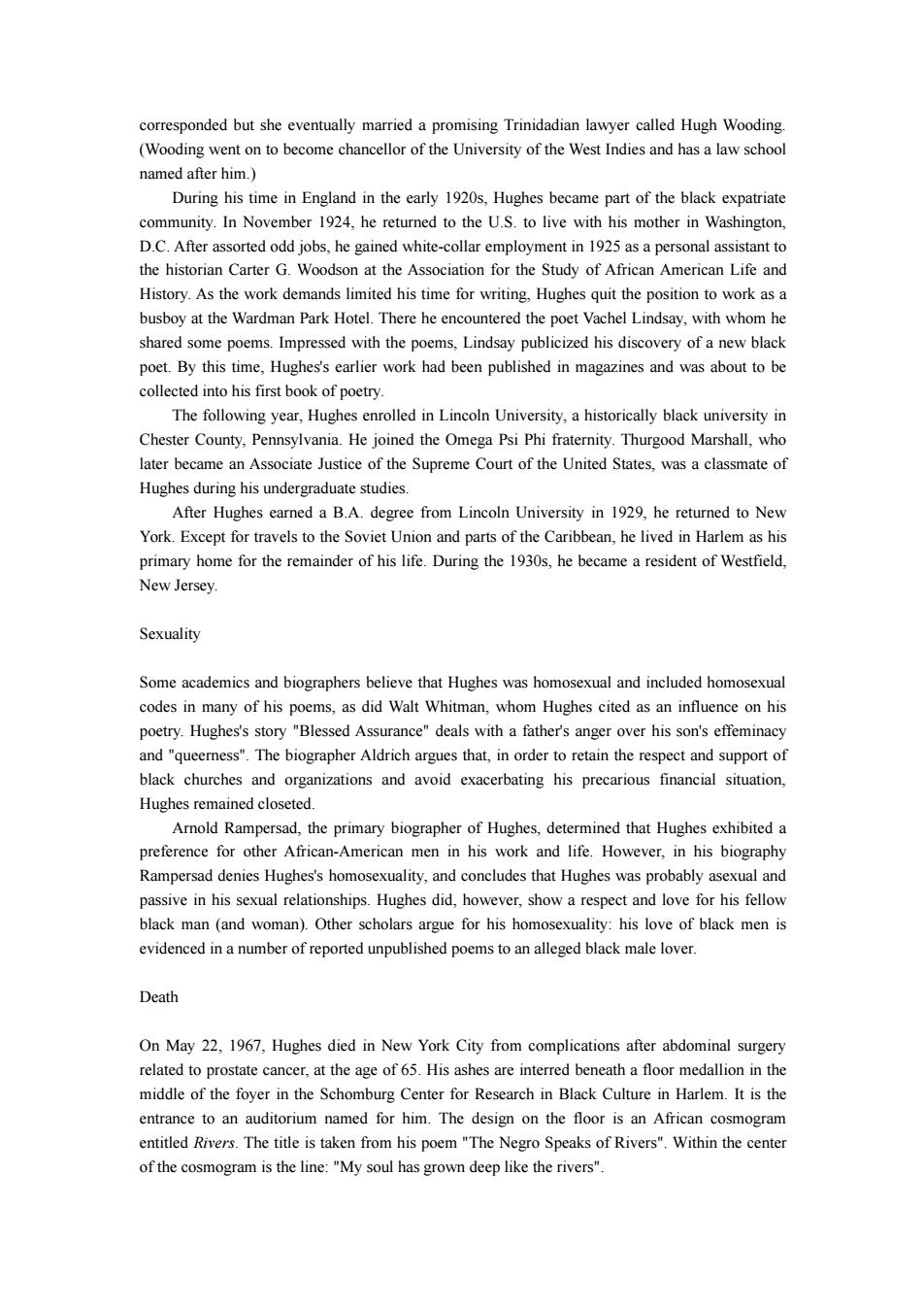
corresponded but she eventually married a promising Trinidadian lawyer called Hugh Wooding (Wooding went on to become chancellor of the University of the West Indies and has a law school named after him.) During his time in England in the early 1920s,Hughes became part of the black expatriate community.In November 1924,he returned to the U.S.to live with his mother in Washington, D.C.After assorted odd jobs,he gained white-collar employment in 1925 as a personal assistant to the historian Carter G.Woodson at the Association for the Study of African American Life and History.As the work demands limited his time for writing,Hughes quit the position to work as a busboy at the Wardman Park Hotel.There he encountered the poet Vachel Lindsay,with whom he shared some poems.Impressed with the poems,Lindsay publicized his discovery of a new black poet.By this time,Hughes's earlier work had been published in magazines and was about to be collected into his first book of poetry. The following year,Hughes enrolled in Lincoln University,a historically black university in Chester County,Pennsylvania.He joined the Omega Psi Phi fraternity.Thurgood Marshall,who later became an Associate Justice of the Supreme Court of the United States,was a classmate of Hughes during his undergraduate studies. After Hughes earned a B.A.degree from Lincoln University in 1929,he returned to New York.Except for travels to the Soviet Union and parts of the Caribbean,he lived in Harlem as his primary home for the remainder of his life.During the 1930s,he became a resident of Westfield, New Jersey. Sexuality Some academics and biographers believe that Hughes was homosexual and included homosexual codes in many of his poems,as did Walt Whitman,whom Hughes cited as an influence on his poetry.Hughes's story "Blessed Assurance"deals with a father's anger over his son's effeminacy and "queerness".The biographer Aldrich argues that,in order to retain the respect and support of black churches and organizations and avoid exacerbating his precarious financial situation, Hughes remained closeted. Arnold Rampersad,the primary biographer of Hughes,determined that Hughes exhibited a preference for other African-American men in his work and life.However,in his biography Rampersad denies Hughes's homosexuality,and concludes that Hughes was probably asexual and passive in his sexual relationships.Hughes did,however,show a respect and love for his fellow black man (and woman).Other scholars argue for his homosexuality:his love of black men is evidenced in a number of reported unpublished poems to an alleged black male lover. Death On May 22,1967,Hughes died in New York City from complications after abdominal surgery related to prostate cancer,at the age of 65.His ashes are interred beneath a floor medallion in the middle of the foyer in the Schomburg Center for Research in Black Culture in Harlem.It is the entrance to an auditorium named for him.The design on the floor is an African cosmogram entitled Rivers.The title is taken from his poem "The Negro Speaks of Rivers".Within the center of the cosmogram is the line:"My soul has grown deep like the rivers
corresponded but she eventually married a promising Trinidadian lawyer called Hugh Wooding. (Wooding went on to become chancellor of the University of the West Indies and has a law school named after him.) During his time in England in the early 1920s, Hughes became part of the black expatriate community. In November 1924, he returned to the U.S. to live with his mother in Washington, D.C. After assorted odd jobs, he gained white-collar employment in 1925 as a personal assistant to the historian Carter G. Woodson at the Association for the Study of African American Life and History. As the work demands limited his time for writing, Hughes quit the position to work as a busboy at the Wardman Park Hotel. There he encountered the poet Vachel Lindsay, with whom he shared some poems. Impressed with the poems, Lindsay publicized his discovery of a new black poet. By this time, Hughes's earlier work had been published in magazines and was about to be collected into his first book of poetry. The following year, Hughes enrolled in Lincoln University, a historically black university in Chester County, Pennsylvania. He joined the Omega Psi Phi fraternity. Thurgood Marshall, who later became an Associate Justice of the Supreme Court of the United States, was a classmate of Hughes during his undergraduate studies. After Hughes earned a B.A. degree from Lincoln University in 1929, he returned to New York. Except for travels to the Soviet Union and parts of the Caribbean, he lived in Harlem as his primary home for the remainder of his life. During the 1930s, he became a resident of Westfield, New Jersey. Sexuality Some academics and biographers believe that Hughes was homosexual and included homosexual codes in many of his poems, as did Walt Whitman, whom Hughes cited as an influence on his poetry. Hughes's story "Blessed Assurance" deals with a father's anger over his son's effeminacy and "queerness". The biographer Aldrich argues that, in order to retain the respect and support of black churches and organizations and avoid exacerbating his precarious financial situation, Hughes remained closeted. Arnold Rampersad, the primary biographer of Hughes, determined that Hughes exhibited a preference for other African-American men in his work and life. However, in his biography Rampersad denies Hughes's homosexuality, and concludes that Hughes was probably asexual and passive in his sexual relationships. Hughes did, however, show a respect and love for his fellow black man (and woman). Other scholars argue for his homosexuality: his love of black men is evidenced in a number of reported unpublished poems to an alleged black male lover. Death On May 22, 1967, Hughes died in New York City from complications after abdominal surgery related to prostate cancer, at the age of 65. His ashes are interred beneath a floor medallion in the middle of the foyer in the Schomburg Center for Research in Black Culture in Harlem. It is the entrance to an auditorium named for him. The design on the floor is an African cosmogram entitled Rivers. The title is taken from his poem "The Negro Speaks of Rivers". Within the center of the cosmogram is the line: "My soul has grown deep like the rivers
